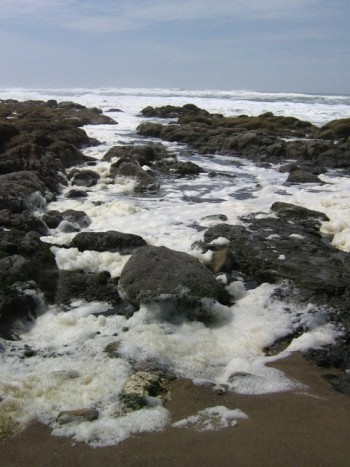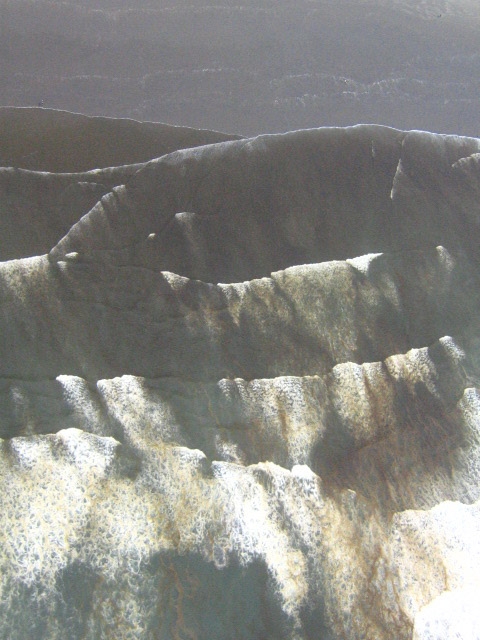
Publisher:
Bonnie King
CONTACT:
Newsroom@Salem-news.com
Advertising:
Adsales@Salem-news.com

~Truth~
~Justice~
~Peace~
TJP
Apr-29-2007 21:27

 TweetFollow @OregonNews
TweetFollow @OregonNews
Brown Waves On Coast Stumping Visitors, Residents
Salem-News.comIt’s actually a form of phytoplankton causing all the raucous - the basic, bottom of the food chain in the ocean on which most all life depends.
 Photos: Andre' Hagestedt |
(SEASIDE, Ore./beachconnection.net/) - It started out all over the coast earlier this month: a great abundance of brown foamy patches on the waves had visitors scratching their heads and asking local merchants about it in huge numbers. The locals, most of the time, didn’t know either.
Now, the phenomenon has dissipated on the central coast, but the Seaside area has foamy chunks that are much darker and stranger than ever before, causing many to barrage Seaside businesses with questions about pollution or if there was a shipwreck spilling oil out there.
It’s actually a form of phytoplankton causing all the raucous - the basic, bottom of the food chain in the ocean on which most all life depends. They’re called diatoms, and they are microscopic plant-like creatures that are actually responsible for most all sea foam you see on the beaches. They are about 100 micrometers long – or 1000 times the size of a virus. Still, they’re not visible with the naked eye.
“It’s a good thing,” said Keith Chandler, manager of the Seaside Aquarium. “It’s a healthy thing. It’s just a lot of diatoms."
In recent weeks, this was so along most of the Oregon coast, including the central coast, where big chunks of brown foam floated lazily along the waves, until some of it washed ashore. There it would create dark, oily-looking patches in the sand as well as large tracts of brown foam and goo along the beaches.
 Along the rest of the coast, it’s mostly disappeared in the last two weeks. But in Seaside, it’s heavier than ever.
Along the rest of the coast, it’s mostly disappeared in the last two weeks. But in Seaside, it’s heavier than ever.
Gary Dieboldt, owner of Flashback Malt Shoppe in Seaside, was asked about it so many times he finally called the Seaside Aquarium to doublecheck on it. “I had about a half dozen, maybe ten people ask me just today,” Dieboldt said. “They’re thinking it’s an oil spill or something, or asking if a ship wrecked out there.”
Above the town, Seaside Helicopters owner Gary Turel is playing answer man to the myriad of tourists flying over the area in his unique amusement ride. “They’re asking me about it all the time,” Turel. “I kept saying I thought it was algae, until I found out what it really was.”
In his helicopter ride, which takes you a high up in the air, you can see the marked difference between Cannon Beach and Seaside. The north side of Tillamook Head, which divides the two towns by six miles, has a lot of brown in it. The Cannon Beach side, to the south, has little to none.
Down on the central coast, there are now only small patches of brown foam, instead of the large ones seen two weeks ago - and even then, nothing like the sepiatone look the Seaside area now has.
“It’s all pretty clear now,” said Guy DiTorrice, a Newport beach expert. “The winds and the currents have washed everything pretty clean, at least from what I saw coming over the bridge today. It’s definitely not what it was two weeks ago.”
The beaches of Lincoln City were much foamier than usual this week, however, indicating there is still a large presence on the central coast. Huge chunks of foam, as well as enormous pools of it are making for strange sights along the central coast, however.
The diatoms eat large amounts of nitrates and phosphates, which are extremely heavy in the freshwater runoffs from the Columbia River, Chandler said. “That’s why it’s so brown here on these beaches. They’re living off the nitrates and phosphates coming down from the Columbia. That creates these huge blooms of diatoms. They’ve got a lot of stuff to feed off. It’s like gravy to these diatoms. Or like pudding to them."
This all spells good times for razor clam fans. “That’s the reason we’ve got the best razor clamming in the world around here, because they eat diatoms,” Chandler said.
On the north end of Seaside, by the Necanicum River, the ocean is littered with clumps of dark stuff and the phenomenon is much more pronounced, likely because the Necanicum adds to the nutrients in the area.
 When diatoms wash ashore, because they’re microscopic, they look like crude oil, said Tiffany Boothe, of the Seaside Aquarium. It’s often mistaken for oil or pollution, but it’s not. Visitors to the Oregon coast will undoubtedly vividly remember seeing dark, oily-looking patches on the beaches, often in great abundance. “If you look very closely at a thin layer of the stuff you will see it is dark green, and not a crude oil at all.”
When diatoms wash ashore, because they’re microscopic, they look like crude oil, said Tiffany Boothe, of the Seaside Aquarium. It’s often mistaken for oil or pollution, but it’s not. Visitors to the Oregon coast will undoubtedly vividly remember seeing dark, oily-looking patches on the beaches, often in great abundance. “If you look very closely at a thin layer of the stuff you will see it is dark green, and not a crude oil at all.”
Diatoms and other types of phytoplankton are also largely responsible for the regular sea foam you see on the coastline. Those bubbles that hit the beaches are from the breakdown of the skeletons of phytoplankton. High winds and heavy surf whip air into the water, and when combined with the dissolved organic matter from the phytoplankton, these help create the bubbles.
Other wild sights are sometimes on tap because of another form of phytoplankton called dinoflagellates. These little creatures glow in the water at night and on the beaches for a few hours after washing up on shore. It’s nicknamed “glowing sands” because they emit a faint, bluish, green glow when stepped on or disturbed. This is only visible in very dark conditions at night.
**********************************************************
Special thanks to Andre' Hagestedt
Articles for April 28, 2007 | Articles for April 29, 2007 | Articles for April 30, 2007





Quick Links
DINING
Willamette UniversityGoudy Commons Cafe
Dine on the Queen
Willamette Queen Sternwheeler
MUST SEE SALEM
Oregon Capitol ToursCapitol History Gateway
Willamette River Ride
Willamette Queen Sternwheeler
Historic Home Tours:
Deepwood Museum
The Bush House
Gaiety Hollow Garden
AUCTIONS - APPRAISALS
Auction Masters & AppraisalsCONSTRUCTION SERVICES
Roofing and ContractingSheridan, Ore.
ONLINE SHOPPING
Special Occasion DressesAdvertise with Salem-News
Contact:AdSales@Salem-News.com
Terms of Service | Privacy Policy
All comments and messages are approved by people and self promotional links or unacceptable comments are denied.
Osotan; April 30, 2007 5:01 pm (Pacific time)
well done and completely informitive S-N! I see it about 8 degrees off the equator also, though not in the same frequency or quantity. I guess we will survive.
[Return to Top]©2025 Salem-News.com. All opinions expressed in this article are those of the author and do not necessarily reflect those of Salem-News.com.